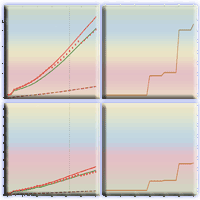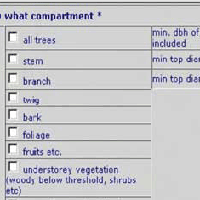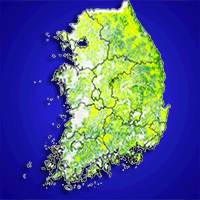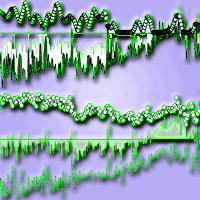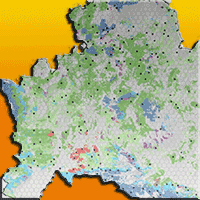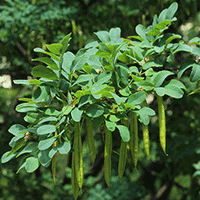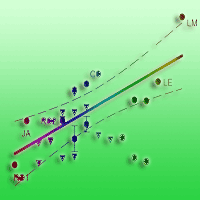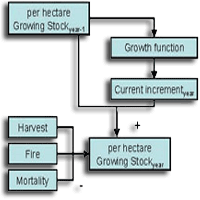
An approach to estimate carbon stocks change in forest carbon pools under the UNFCCC: the Italian case
S Federici (1) , M Vitullo (2), S Tulipano (1), R De Lauretis (2), G Seufert (1)
iForest - Biogeosciences and Forestry, Volume 1, Issue 2, Pages 86-95 (2008)
doi: https://doi.org/10.3832/ifor0457-0010086
Published: May 20, 2008 - Copyright © 2008 SISEF
Research Articles
Abstract
Under the UNFCCC, Annex I Parties must report annually a National GHG Inventories of anthropogenic emissions by sources and removals by sinks. LULUCF is one of the six sectors of the inventory: in this sector any emissions and removals of GHGs by land management should be reported, included the large GHGs fluxes generated by forest management and land-use changes into and from forest. In this context every Party has to produce a proper model in order to be able to fulfil GHGs Inventory request for forest sector. Taking Italy as a study case, the paper aims at presenting a new methodology for updating stock changes for years between national forest inventories, in order to reproduce annual stock changes in the five UNFCCC forest carbon pools, following the UNFCCC requirements in the context of carbon reporting.
Keywords
Carbon stock, GHG inventory, LULUCF, Yield model, Sink, C pools
Authors’ Info
Authors’ address
S Tulipano
G Seufert
European Commission’s Joint Research Centre, Climate Change Unit, v. E. Fermi 1, Ispra, Varese (Italy)
R De Lauretis
APAT, Agenzia per la Protezione dell’Ambiente e per i Servizi Tecnici, v. C. Pavese 313, Roma (Italy)
Corresponding author
Paper Info
Citation
Federici S, Vitullo M, Tulipano S, De Lauretis R, Seufert G (2008). An approach to estimate carbon stocks change in forest carbon pools under the UNFCCC: the Italian case. iForest 1: 86-95. - doi: 10.3832/ifor0457-0010086
Paper history
Received: Jun 14, 2007
Accepted: Jan 24, 2008
First online: May 20, 2008
Publication Date: May 20, 2008
Publication Time: 3.90 months
Copyright Information
© SISEF - The Italian Society of Silviculture and Forest Ecology 2008
Open Access
This article is distributed under the terms of the Creative Commons Attribution-Non Commercial 4.0 International (https://creativecommons.org/licenses/by-nc/4.0/), which permits unrestricted use, distribution, and reproduction in any medium, provided you give appropriate credit to the original author(s) and the source, provide a link to the Creative Commons license, and indicate if changes were made.
Web Metrics
Breakdown by View Type
Article Usage
Total Article Views: 58720
(from publication date up to now)
Breakdown by View Type
HTML Page Views: 44996
Abstract Page Views: 5658
PDF Downloads: 6850
Citation/Reference Downloads: 91
XML Downloads: 1125
Web Metrics
Days since publication: 6425
Overall contacts: 58720
Avg. contacts per week: 63.98
Citation Metrics
Article Citations
Article citations are based on data periodically collected from the Clarivate Web of Science web site
(last update: Mar 2025)
Total number of cites (since 2008): 68
Average cites per year: 3.78
Publication Metrics
by Dimensions ©
Articles citing this article
List of the papers citing this article based on CrossRef Cited-by.
References
Stima dei consumi di legna da ardere per riscaldamento ed uso domestico in Italia, Rapporto Finale. ARPA Lombardia, Milano.
Gscholar
Growth prediction and site determination in uneven-aged timber stands. Journal of Agricoltural Research 56 (2): 81-98.
Gscholar
Global Forest Resources Assessment 2005. Main Report Italy - Country Report, UN/ECE- FAO.
Gscholar
Good Practice Guidance and Uncertainty Management in National Greenhouse Gas Inventories. IPCC National Greenhouse Gas Inventories Programme, Technical Support Unit, Hayama, Kanagawa, Japan.
Gscholar
Good Practice Guidance for Land Use, Land-Use Change and Forestry. IPCC Technical Support Unit, Kanagawa, Japan.
Gscholar
Structure and yield of all-sized and even-sized conifer-dominated stands on fertile sites. Ann. Sci. For. 51: 97-109.
Gscholar
Om tynning i enaldret gran-og furuskog, Referat: Produktionsuntersuchungen von Fichtenwald. Medd. Det norske Skogforsoksvesen 8: 131-216.
Gscholar
Inventario Forestale Nazionale. Sintesi metodologica e risultati. Ministero dell’Agricoltura e delle foreste. Istituto Sperimentale per l’assestamento forestale e per l’Alpicoltura, Trento.
Gscholar
The human footprint in the carbon cycle of temperate and boreal forests. Nature 447: 848-850.
CrossRef | Gscholar
Is inherent variation in RGR determined by LAR at low irradiance and by NAR at high irradiance? A review of herbaceous species. In: Inherent Variation in Plant Growth; Physiological Mechanisms and Ecological Consequences (Lambers H, Poorter H, van Vuuren MMI eds). Backhuys Publishers, Leiden, The Netherlands, pp. 309-336.
Gscholar
Natural and Managed Stand Yield Tables for the Merritt IFPA Innovative Analysis Project: MTI-402, Prepared for Nicola-Similkameen Innovative Forestry Society Merritt, British Columbia, Canada.
Gscholar

